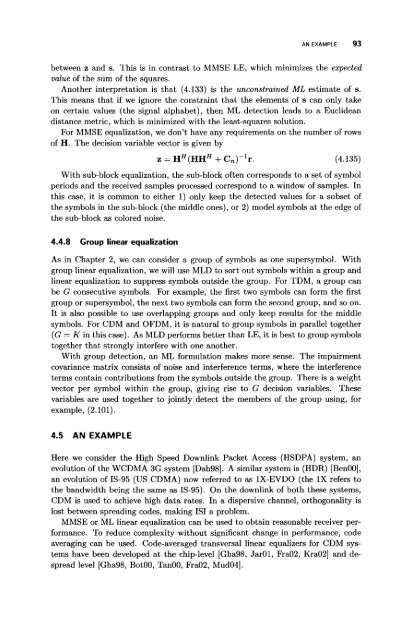mohatta2015.pdf
signal processing from power amplifier operation control point of view
signal processing from power amplifier operation control point of view
Create successful ePaper yourself
Turn your PDF publications into a flip-book with our unique Google optimized e-Paper software.
AN EXAMPLE 93<br />
between z and s. This is in contrast to MMSE LE, which minimizes the expected<br />
value of the sum of the squares.<br />
Another interpretation is that (4.133) is the unconstrained ML estimate of s.<br />
This means that if we ignore the constraint that the elements of s can only take<br />
on certain values (the signal alphabet), then ML detection leads to a Euclidean<br />
distance metric, which is minimized with the least-squares solution.<br />
For MMSE equalization, we don't have any requirements on the number of rows<br />
of H. The decision variable vector is given by<br />
z = H H (HH H +C„)- 1 r. (4.135)<br />
With sub-block equalization, the sub-block often corresponds to a set of symbol<br />
periods and the received samples processed correspond to a window of samples. In<br />
this case, it is common to either 1) only keep the detected values for a subset of<br />
the symbols in the sub-block (the middle ones), or 2) model symbols at the edge of<br />
the sub-block as colored noise.<br />
4.4.8 Group linear equalization<br />
As in Chapter 2, we can consider a group of symbols as one supersymbol. With<br />
group linear equalization, we will use MLD to sort out symbols within a group and<br />
linear equalization to suppress symbols outside the group. For TDM, a group can<br />
be G consecutive symbols. For example, the first two symbols can form the first<br />
group or supersymbol, the next two symbols can form the second group, and so on.<br />
It is also possible to use overlapping groups and only keep results for the middle<br />
symbols. For CDM and OFDM, it is natural to group symbols in parallel together<br />
(G = K in this case). As MLD performs better than LE, it is best to group symbols<br />
together that strongly interfere with one another.<br />
With group detection, an ML formulation makes more sense. The impairment<br />
covariance matrix consists of noise and interference terms, where the interference<br />
terms contain contributions from the symbols outside the group. There is a weight<br />
vector per symbol within the group, giving rise to G decision variables. These<br />
variables are used together to jointly detect the members of the group using, for<br />
example, (2.101).<br />
4.5 AN EXAMPLE<br />
Here we consider the High Speed Downlink Packet Access (HSDPA) system, an<br />
evolution of the WCDMA 3G system [Dah98]. A similar system is (HDR) [BenOO],<br />
an evolution of IS-95 (US CDMA) now referred to as 1X-EVDO (the IX refers to<br />
the bandwidth being the same as IS-95). On the downlink of both these systems,<br />
CDM is used to achieve high data rates. In a dispersive channel, orthogonality is<br />
lost between spreading codes, making ISI a problem.<br />
MMSE or ML linear equalization can be used to obtain reasonable receiver performance.<br />
To reduce complexity without significant change in performance, code<br />
averaging can be used. Code-averaged transversal linear equalizers for CDM systems<br />
have been developed at the chip-level [Gha98, JarOl, Fra02, Kra02] and despread<br />
level [Gha98, BotOO, TanOO, Fra02, Mud04].



